Answer:
How to approach the answer
- Introduction:
- Write about the Tribal movement in brief in the age of development.
- Body:
- Write about the various causes behind the tribal movement.
- Then write how they raise the question of social justice in the independence era.
- Conclusion:
- Conclude based on the above points.
|
Introduction:
Tribal movements in post-independence India were started due to the issue of tribal eviction from forest areas to promote heavy industries, mining to extract the minerals for economic growth and support development.
Body
Tribal Movements as a result of compromised social justice:

- Lack of proper rehabilitation: Tribal movements have been caused due to insufficient rehabilitation against the development works like dam construction, mining etc. Example- Tribal eviction due to dam construction on Narmada river.
- Movement for socio-political autonomy: Various tribal groups have mobilized themselves to demand socio- political autonomy, e.g. Naga movement etc.
- Resource Exploitation: Tribal regions in India are often rich in natural resources like minerals, water, and forests. The exploitation of these resources by government and private entities further marginalized tribal communities and lead to conflicts over resource ownership and control. Example- Niyamgiri land conflict.
- Agrarian movement: The Naxalbari movement, Brisadal movement etc. were organized against the callousness of the government against poor agrarian conditions of tribals.
- Land acquisition: Tribals have protested against land acquisition for development projects, e.g. Movement of tribals in Sundargarh district of Odisha against Dalmia cement.
- Socio-cultural movement: Tribals have also organized themselves against the influx of outsiders into their region threatening their way of life, e.g. Jharkhand movement
- Forest exploitation: Tribals have organised themselves against destruction of forests. They also feel that acts like PESA and Forest Rights Act are not adequate. e.g. Chipko movement, appiko movement etc.
Measures that can be taken:
- Comprehensive ESIA: Comprehensive environmental and social impact assessment should be conducted before development projects to gauge its impact on tribals and their way of life.
- Resettlement and Rehabilitation: When development projects necessitate displacement, adequate and just resettlement along with rehabilitation measures should be implemented. Example- PM Khanij Kshetra Kalyan Yojna.
- Protection of culture: Tribal culture should be preserved with proper implementation of PESA Act 1996 and Forest Rights Act 2006 etc in tribal areas.
- Education and Skill Development: Access to quality education and skill development programs is crucial for tribal empowerment. Special efforts should be made to improve educational facilities in tribal areas and promote education that respects their culture and traditions. Example- Eklavya Residential Schools.
- Joint forest management: Tribals should be involved in management of forests to promote employment opportunities and a sense of trust with the forest department.
- Value addition: Promotion of value addition in minor forest produce with initiatives like Van- Dhan Yojana can reduce income inequalities among tribals.
Conclusion:
Inclusive development is not just a contemporary catchword but is the need of hour for a country like India. The tribal movement highlights the deep-rooted social injustice against tribals and underlines the need for their socio-economic development along the principles of Tribal Panchsheel.
To get PDF version, Please click on "Print PDF" button.


Latest Comments